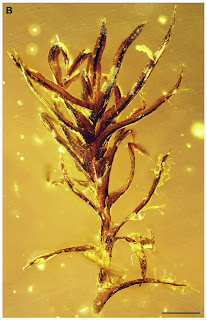Moss spores are small single celled packages that play a crucial role in establishing new populations. These tiny units are blown by the wind and then landing somewhere suitable, grow into a new moss plant. They enable mosses to spread far and wide across the globe.
There are two strategies for releasing spores.
Xerochastic = capsules are open and spores are released when conditions are dry.
Hygrochastic = capsules are open and spores are released when conditions are wet.
We might expect to that plants with different strategies for spore release also have different types of spores. Maybe those that are released during wet conditions are primed to develop more quickly and those released when it is dry have more long-term energy storage to increase their survival until conditions are good for growth.
In a recent study, Nagore Medina explored the question of whether spores have different characteristics between those that have xerochastic vs. hygrochastic dispersal in seven closely related Orthotrichum species. She used Transmission Electron Microscopy to examine the spore ultrastructure to determine if there were any differences between the species.
She found that the two hygrochastic species that disperse when conditions are wet have slightly smaller amounts of lipids inside. Think of the lipids as fat storage that helps the spores make it through tough times when they are not producing new food. This points toward these spores being less prepared to survive long-term out in the world prior to growing.
Also the hygrochastic species have higher proportions of bicellular spores. Usually spores are just a single cell, as I mentioned earlier, but of course in biology there are always exceptions to the rule. Life is gloriously messy like that! They interpret the bicellular spores as a sign of early germination. Think of these spores being ready to hit the ground growing. They are so prepared that they already started dividing to produce more cells.
Examples of this spore difference are visible in the images below. The two on the left have bicellular spores. There is a thin line running through the middle of the spore labeled "CW" indicating where a new cell wall has formed separating the two cells on either side. The spores on the right are each composed of only a single cell.
 |
From Medina & Estébanez 2014. Transverse sections through the spores.
Two hygrochastic species on the left. Two xerochastic species on the right.
Upper Left: Figure 1C. Lower Left: Figure 4C. Upper Right: Figure 6D. Lower Right: Figure 7D. |
These are the main differences that they found between the spores of hygrochastic and xerochastic species. Unfortunately no other significant differences were found between the spores. But that is how it sometimes goes with science. Scientists come up with an interesting hypothesis that predicts a particular pattern and you find a bit of data supporting your prediction, but not nearly as much as you had hoped to make a very strong conclusion. Instead there is a bit of evidence supporting your idea, which may be just enough to keep you trying out the next experiment to see where the explorations will take you.
Nagore G. Medina & Belén Estébanez. 2014. Does spore ultrastructure mirror different dispersal strategies in mosses? A study of seven iberianOrthotrichum species. 9 (11): e112867.













































